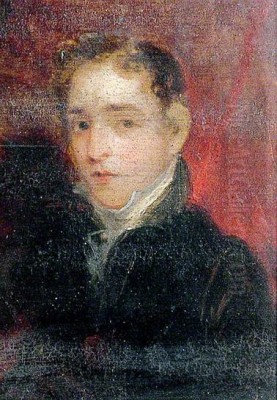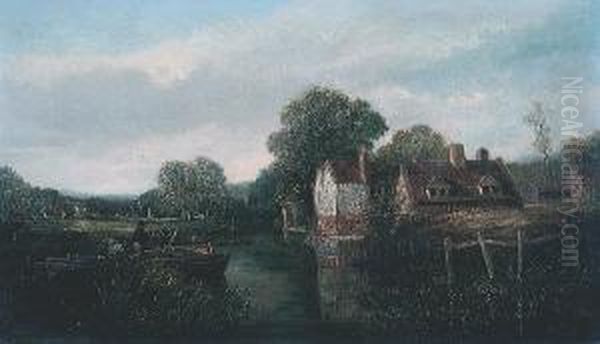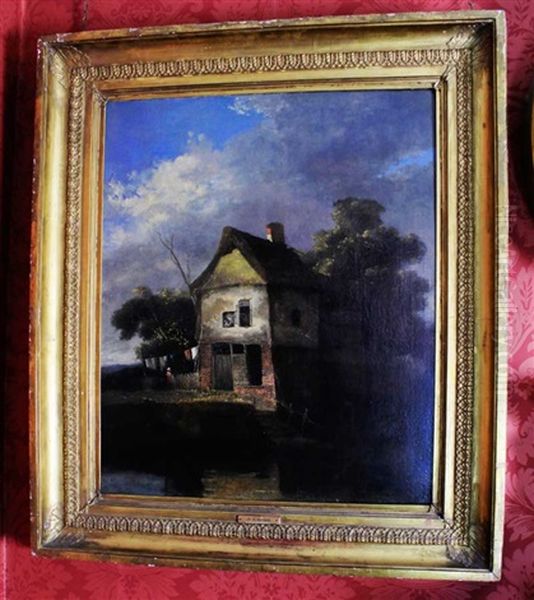
John Berney Crome stands as a significant figure in the history of British landscape painting, particularly associated with the celebrated Norwich School of Artists. As the eldest son of the renowned painter John Crome, often referred to as 'Old Crome', John Berney Crome inherited not only a name but also a profound artistic tradition. Living from 1794 to 1842, his life and career were deeply intertwined with the artistic milieu of Norwich, a city that became the heart of England's first provincial art movement. While sometimes overshadowed by his father's towering reputation, John Berney Crome carved out his own identity as a painter, teacher, and leading member of the Norwich Society of Artists, leaving behind a body of work appreciated for its sensitivity to light and atmosphere, especially in depictions of his native Norfolk landscape.
Early Life and Artistic Formation
Born in Norwich on December 8, 1794, John Berney Crome entered a world already shaped by his father's burgeoning artistic career. John 'Old' Crome was a foundational figure of the Norwich School, and his home was undoubtedly a hub of artistic activity and discussion. Young John Berney received his formal education at the Norwich Grammar School, where he remained until the age of eighteen. Unlike some artists who dedicate themselves solely to art from a very young age, Crome had a solid academic grounding before fully committing to painting.
However, the most crucial part of his artistic education undoubtedly came from his father. He learned the craft directly under the guidance of Old Crome, absorbing the techniques and aesthetic principles that defined the Norwich School. This involved close observation of nature, a focus on the local Norfolk scenery, and an appreciation for the Dutch landscape masters of the 17th century. He became his father's assistant, learning not just the practicalities of painting but also the business of being an artist, including teaching. This apprenticeship set the stage for his own independent career.
The Norwich School Context

To understand John Berney Crome's contribution, it is essential to appreciate the context of the Norwich School of Artists. Founded in 1803 by his father, John Crome, and Robert Ladbrooke, the Norwich Society of Artists aimed to provide a forum for local artists to exhibit their work and foster artistic development outside London. It was a unique phenomenon in British art history, representing a cohesive group of artists inspired by their shared local environment.
The Norwich School artists primarily focused on landscape painting, drawing inspiration from the distinctive scenery of Norfolk – its broads, rivers, woodlands, coastal areas, and rural life. Key figures alongside the Cromes included John Sell Cotman, James Stark, George Vincent, Joseph Stannard, and his brother Alfred Stannard. These artists shared an interest in realism, careful observation, and the atmospheric effects of light, often looking back to the Dutch Golden Age painters like Meindert Hobbema and Jacob van Ruisdael for inspiration, as well as earlier British landscape painters such as Richard Wilson and Thomas Gainsborough. John Berney Crome grew up within this vibrant artistic community and became one of its leading figures in the generation following the founders.
Artistic Style and Influences
John Berney Crome's artistic style is firmly rooted in the Norwich School tradition established by his father. He specialized in landscapes and coastal scenes, primarily depicting the familiar environs of Norfolk and Suffolk. Like his father, he worked in both oil and watercolour, and also produced etchings, although he is best known for his oil paintings. His works are characterized by a careful attention to detail, a strong sense of place, and a particular sensitivity to the effects of light and atmosphere.
A distinctive feature of John Berney Crome's oeuvre is his fondness for moonlight scenes and twilight effects. While Old Crome also painted nocturnal scenes, John Berney made them a more frequent subject, often imbuing them with a quiet, romantic sensibility. His handling of light, whether the silvery glow of the moon or the dramatic contrasts of a storm, demonstrates considerable technical skill. His compositions often feature tranquil riverscapes, wooded lanes, and coastal views, rendered with a slightly softer, perhaps more polished finish than some of his father's more rugged works.

His influences are clear: primarily his father, John Crome, whose approach to naturalism and composition he largely followed. The legacy of 17th-century Dutch painters, particularly Meindert Hobbema, Jacob van Ruisdael, and Aelbert Cuyp, is evident in the detailed rendering of foliage, the low horizons, and the emphasis on sky and atmosphere. He also absorbed lessons from British landscape pioneers like Richard Wilson and Thomas Gainsborough, blending Dutch realism with a native sensibility.
Key Works and Subjects
Several works stand out as representative of John Berney Crome's style and thematic interests. One of his most famous paintings is Yarmouth Water Frolic – Evening, Boats Assembling Previous to the Rowing Match, exhibited in 1821. This large canvas captures a specific local event, depicting numerous boats gathered on the water under an atmospheric evening sky. It showcases his ability to handle complex compositions involving figures and boats, combined with his skill in rendering water and light effects. The painting reflects the social life of the region as well as its natural beauty.
Another notable work, Near the New Mill at Norwich (c. 1814-1817), demonstrates his ability to capture the tranquil charm of the Norfolk countryside, focusing on the interplay of light on water and foliage near a local landmark. His coastal scenes, such as depictions of the Yarmouth area, often captured the dramatic weather of the East Anglian coast. Works like Great Gale at Yarmouth on Ash Wednesday convey the power of nature, a theme popular within the Romantic movement.
Moonlight scenes were a recurring subject, allowing him to explore subtle tonal variations and create evocative moods. These paintings, often featuring rivers or coastal estuaries under the moon, became something of a signature for him. While his subject matter largely mirrored that of his father and the Norwich School generally – local landscapes, trees, rivers, coastlines – his particular emphasis on nocturnal and crepuscular effects helped distinguish his output.
Career and the Norwich Society
Following his father's death in 1821, John Berney Crome stepped into a more prominent role within the Norwich art scene. He took over his father's successful teaching practice, instructing pupils in drawing and painting, thereby continuing the Crome family's influence on local art education. Among his pupils was the talented landscape painter John Middleton. He also continued his father's house and practice in Gildengate Street, Norwich.
His involvement with the Norwich Society of Artists (which had briefly ceased exhibitions but was revived) was significant. He exhibited regularly with the Society from a young age, starting around 1806. He became the Society's Vice-President in 1830 and served as President on several occasions, demonstrating his leadership within the local artistic community. He was committed to the Society's aims of promoting local talent and providing exhibition opportunities.
Beyond Norwich, John Berney Crome also sought recognition on the national stage, though less consistently than his father or John Sell Cotman. He exhibited works at the Royal Academy in London between 1811 and 1843, and also showed paintings at the British Institution. These London exhibitions helped to bring the Norwich School's distinctive style to a wider audience, although the group remained primarily associated with its regional base.
Personal Life and Challenges
John Berney Crome married Phoebe Berney, and the couple had six children. His family life ran parallel to his artistic career, grounding him in the Norwich community. However, his life was not without difficulties. Sources suggest he lived somewhat extravagantly, perhaps beyond his means. This led to severe financial problems, culminating in bankruptcy in 1831.
The bankruptcy forced him to sell the contents of his father's house, including personal effects and potentially artworks, as well as his own paintings. This must have been a deeply challenging period personally and professionally. Following this setback, he left Norwich for a time, relocating to Bury St Edmunds in Suffolk, where he continued to work as a painter and likely sought to rebuild his career away from the immediate pressures in Norwich.
Despite these difficulties, he eventually returned to the region. He died relatively young, at the age of 48, on September 15, 1842, in Great Yarmouth, a coastal town he frequently depicted in his paintings. He was buried near his father in the churchyard of St George's Church, Colegate, Norwich, bringing his life's journey back to the city that had defined his artistic identity.
Relationship with John Crome ('Old Crome')
The relationship between John Berney Crome and his father, John Crome, is central to understanding his career. Being the son of such a celebrated artist provided both advantages and challenges. He received unparalleled artistic training from birth and inherited a respected name and established practice. This undoubtedly facilitated his entry into the Norwich art world and provided him with opportunities.
However, the towering reputation of 'Old Crome' inevitably cast a long shadow. John Berney Crome's style remained closely aligned with his father's, leading to frequent comparisons and, at times, difficulties in establishing his own distinct artistic identity. His works have occasionally been misattributed to his father, particularly earlier pieces or those unsigned. While skilled and accomplished in his own right, he is often perceived as continuing his father's vision rather than forging a radically new path.
Some critics have suggested that John Berney's work, while technically proficient and often beautiful, sometimes lacked the robust vigour and profound connection to the earth found in his father's best paintings. His preference for moonlight scenes and perhaps a slightly smoother finish might be seen as reflecting a different, possibly more conventionally Romantic, sensibility. Nevertheless, he successfully carried the Norwich School aesthetic into the mid-19th century, ensuring the continuation of its traditions after the passing of the founding generation.
Legacy and Reputation
John Berney Crome is remembered as a key member of the second generation of the Norwich School of Artists. While not achieving the same level of fame as his father or John Sell Cotman, he was a highly competent and sensitive landscape painter who made a significant contribution to the movement. His dedication to the Norwich Society of Artists helped sustain the group after his father's death, and his role as a teacher influenced younger artists like John Middleton and potentially others such as Henry Bright.
His paintings, particularly his atmospheric moonlight and coastal scenes, are appreciated for their technical skill and evocative beauty. Works like Yarmouth Water Frolic remain important documents of regional life and artistic achievement. His art is represented in major public collections, including the Norwich Castle Museum & Art Gallery (which holds the most extensive collection of Norwich School works), the Tate Britain in London, and other regional galleries in the UK.
Although his career was marked by financial struggles and the challenge of living up to his father's legacy, John Berney Crome holds a secure place in the history of British landscape painting. He stands alongside other important Norwich School figures such as his brother William Henry Crome (also a painter), James Stark, George Vincent, the Stannard family (Joseph, Alfred, and Eloise Harriet Stannard), John Thirtle, and Miles Edmund Cotman (John Sell Cotman's son), as part of a unique and influential regional school that celebrated the beauty of the English landscape.
Conclusion
John Berney Crome's life (1794-1842) spanned a crucial period for the Norwich School, bridging the founding generation led by his father and the later phases of the movement. Trained by 'Old Crome' himself, he absorbed the core principles of the school – fidelity to nature, focus on local scenery, and inspiration from Dutch masters – and applied them with considerable skill and sensitivity. His specialization in moonlight scenes added a distinct note to the Norwich repertoire. Despite personal challenges and the inevitable comparisons with his father, he played a vital role as an artist, teacher, and leader within the Norwich Society of Artists. His work remains a testament to the enduring appeal of the Norfolk landscape and the artistic vitality of England's first provincial art movement.